Being on the West Coast, I’ve discovered a few things about their culinary options. One thing that I appreciate is the amount of fast food options. While I’ve encountered a good variety I wasn’t anticipating, there’s one restaurant I was fully anticipating: In-N-Out. The burger chain has become one of the most successful burger chains and a staple of West Coast culture. While they’re definitely known for the quality, something about this brand has make them more recognizable than others.
The Product
Like any restaurant, In-N-Out would be nothing if there wasn’t some consistency behind their food. There are a few critical elements to their success, one being freshness and quality. In terms of their burgers, the meat isn’t frozen and they’re prepared in plain sight. You can see the potatoes being turned to fries and there’s no secrets in the kitchen. Regardless of your opinion on the food, you can be confident in the quality of the ingredients and preparation. For a brand, this is critical. At In-N-Out’s core it’s a burger chain and they deliver their product well.
Quality food is expected from a restaurant, but customers service forms the experience as well. In-N-Out has ranked as America’s favorite fast-serve restaurant in customer satisfaction. This is pretty remarkable for a notoriously popular restaurant. If you’re a burger lover near an In-N-Out, it seems like an obvious choice to get your burger fix.
The quality product and the customer service has given In-N-Out the ability to expand. According to Wikipedia, they currently have 335 locations in the US so they’ve expanded quite a bit. Yet these locations remain in California, Nevada, Arizona, Utah, and Texas. Such a popular and profitable brand could expand to the east, but they haven’t.
The Brand

In-N-Out is a California brand, and the materials they use reflect that. When your fries come in a container covered in palm trees, you know you’re in a warmer climate. It’s important for the packing to reflect the location, because nothing about California screams burgers and fries. Meanwhile, the signage is simple but looks dated. With a glowing arrow pointing toward their door, the restaurant is inviting customers in. It also looks like a diner from the 50’s, and I believe this is intentional. The menu is very simple and only has a few options. People who went to In-N-Out decades ago can expect to find the same menu at reasonable prices.
With all of these elements, In-N-Out has become a staple to the West Coast. If you’re going to California and post a picture of a palm tree-covered cup, people know where you’ve eaten. Because there is so little change, even the East Coast is familiar with the branding. People from the east want to try it, but they can’t unless they travel. Perhaps In-N-Out wants to remain exclusive, or maybe they just don’t want to rush their expansion. Either way, East Coasters want a taste of these burgers and the special sauce.
Of course, modern times have amplified the brand’s messaging. Not only does social media allow for people to humble brag when they’ve gone to In-N-Out, but the restaurant is also frequently mentioned on secret menu lists. It’s easy for In-N-Out to embrace this trend. They’re only preparing a handful of items. People may mix-and-match to create concoctions not on the menu, but the kitchen is already making all the tools needed for the secret delights. So the restaurant will honor the secret menu and makes the customer happy in the process.
In-N-Out Makes it Work
It was a simple formula to build In-N-Out’s reputation and the brand executed it well. Make a great product, treat your customers well, embrace your environment, then repeat the process. This has built such a large audience that the brand is respected on both coasts. Even when the East Coast can’t access the restaurants, the reputation proceeds the brand. It’s the right mix of good food, specialization, and California cool that keeps people coming and keeps paints the brand in such a great light.






You must be logged in to post a comment.